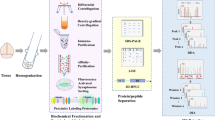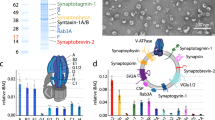Abstract
Recent advances in the identification and analysis of protein–protein interaction complexes associated with synapses and synaptic proteins deepened not only our insights into the molecular composition and dynamic structural makeup of interneuronal connections but contributed also significantly to our understanding of the molecular and mechanistic aspects underlying functional plasticity in neuronal networks. In particular proteome analytical tools, combining traditional isolation protocols with modern mass spectrometric approaches, were utilized successfully for the molecular analysis of chemical synapses and other neuronal subcellular structures revealing new and exciting insights into the temporal and spatial changes of the proteins composing or associated with for example synaptic vesicles, synaptic membranes, or postsynaptic densities (PSDs). Proteomic approaches may thus offer also a chance to gain valuable insights into the so far elusive molecular composition of electrical synapses, the Cinderella fated and long neglected little brethren of “classical” chemical synapses. In this chapter we provide an experimental basis of how such an analysis can be designed, with a major focus on the most abundant electrical synapse protein, connexin36.
Access this chapter
Tax calculation will be finalised at checkout
Purchases are for personal use only
Similar content being viewed by others
References
Furshpan EJ, Potter DD (1959) Transmission at the giant motor synapses of the crayfish. J Physiol 145(2):289–325
Furshpan EJ, Potter DD (1957) Mechanism of nerve-impulse transmission at a crayfish synapse. Nature 180(4581):342–343
Costain WJ et al (2010) Proteomic analysis of synaptosomal protein expression reveals that cerebral ischemia alters lysosomal Psap processing. Proteomics 10(18):3272–3291
Bai F, Witzmann FA (2007) Synaptosome proteomics. Subcell Biochem 43:77–98
Witzmann FA et al (2005) A proteomic survey of rat cerebral cortical synaptosomes. Proteomics 5(8):2177–2201
Grant SG et al (2005) Synapse proteomics of multiprotein complexes: en route from genes to nervous system diseases. Hum Mol Genet 14 Spec No. 2:R225–R234
Jordan BA et al. (2006) New tricks for an old dog: proteomics of the PSD
Li X, Lu S, Nagy JI (2009) Direct association of connexin36 with zonula occludens-2 and zonula occludens-3. Neurochem Int 54(5–6):393–402
Flores CE et al (2008) Interaction between connexin35 and zonula occludens-1 and its potential role in the regulation of electrical synapses. Proc Natl Acad Sci U S A 105(34):12545–12550
Li X et al (2004) Neuronal connexin36 association with zonula occludens-1 protein (ZO-1) in mouse brain and interaction with the first PDZ domain of ZO-1. Eur J Neurosci 19(8):2132–2146
Burr GS et al (2005) Calcium-dependent binding of calmodulin to neuronal gap junction proteins. Biochem Biophys Res Commun 335(4):1191–1198
Bissiere S et al (2011) Electrical synapses control hippocampal contributions to fear learning and memory. Science 331(6013):87–91
LeBeau FE et al (2003) The role of electrical signaling via gap junctions in the generation of fast network oscillations. Brain Res Bull 62(1):3–13
Rozental R, Giaume C, Spray DC (2000) Gap junctions in the nervous system. Brain Res Brain Res Rev 32(1):11–15
Haas JS, Zavala B, Landisman CE (2011) Activity-dependent long-term depression of electrical synapses. Science 334(6054):389–393
Hayut I et al (2011) LTS and FS inhibitory interneurons, short-term synaptic plasticity, and cortical circuit dynamics. PLoS Comput Biol 7(10):e1002248
Wang Y, Belousov AB (2011) Deletion of neuronal gap junction protein connexin 36 impairs hippocampal LTP. Neurosci Lett 502(1):30–32
Wu CL et al (2011) Heterotypic gap junctions between two neurons in the drosophila brain are critical for memory. Curr Biol 21(10):848–854
Lisman JE, McIntyre CC (2001) Synaptic plasticity: a molecular memory switch. Curr Biol 11(19):R788–R791
Barria A, Malinow R (2005) NMDA receptor subunit composition controls synaptic plasticity by regulating binding to CaMKII. Neuron 48(2):289–301
Sanhueza M et al (2011) Role of the CaMKII/NMDA Receptor Complex in the Maintenance of Synaptic Strength. J Neurosci 31(25):9170–9178
Duffy HS et al (2002) pH-dependent intramolecular binding and structure involving Cx43 cytoplasmic domains. J Biol Chem 277(39):36706–36714
Alev C et al (2008) The neuronal connexin36 interacts with and is phosphorylated by CaMKII in a way similar to CaMKII interaction with glutamate receptors. Proc Natl Acad Sci U S A 105(52):20964–20969
Gattiker A, Gasteiger E, Bairoch A (2002) ScanProsite: a reference implementation of a PROSITE scanning tool. Appl Bioinformatics 1(2):107–108
Yap KL et al (2000) Calmodulin target database. J Struct Funct Genomics 1(1):8–14
Washburn MP, Wolters D, Yates JR 3rd (2001) Large-scale analysis of the yeast proteome by multidimensional protein identification technology. Nat Biotechnol 19(3):242–247
Link AJ et al (1999) Direct analysis of protein complexes using mass spectrometry. Nat Biotechnol 17(7):676–682
Elias JE et al (2005) Comparative evaluation of mass spectrometry platforms used in large-scale proteomics investigations. Nat Methods 2(9):667–675
Urschel S et al (2006) Protein kinase A-mediated phosphorylation of connexin36 in mouse retina results in decreased gap junctional communication between AII amacrine cells. J Biol Chem 281(44):33163–33171
Kothmann WW et al (2007) Connexin 35/36 is phosphorylated at regulatory sites in the retina. Vis Neurosci 24(3):363–375
Blom N, Gammeltoft S, Brunak S (1999) Sequence and structure-based prediction of eukaryotic protein phosphorylation sites. J Mol Biol 294(5):1351–1362
Xue Y et al (2011) GPS 2.1: enhanced prediction of kinase-specific phosphorylation sites with an algorithm of motif length selection. Protein Eng Des Sel 24(3):255–260
Iakoucheva LM et al (2004) The importance of intrinsic disorder for protein phosphorylation. Nucleic Acids Res 32(3):1037–1049
Huang HD et al (2005) KinasePhos: a web tool for identifying protein kinase-specific phosphorylation sites. Nucleic Acids Res 33(Web Server issue):W226–W229
Hilder TL et al (2007) Proteomic identification of the cerebral cavernous malformation signaling complex. J Proteome Res 6(11):4343–4355
Chang IF (2006) Mass spectrometry-based proteomic analysis of the epitope-tag affinity purified protein complexes in eukaryotes. Proteomics 6(23):6158–6166
Barnouin K (2004) Two-dimensional gel electrophoresis for analysis of protein complexes. Methods Mol Biol 261:479–498
Graumann J et al (2004) Applicability of tandem affinity purification MudPIT to pathway proteomics in yeast. Mol Cell Proteomics 3(3):226–237
Li X et al (2009) Proteomic screen for multiprotein complexes in synaptic plasma membrane from rat hippocampus by blue native gel electrophoresis and tandem mass spectrometry. J Proteome Res 8(7):3475–3486
Jordan BA et al (2004) Identification and verification of novel rodent postsynaptic density proteins. Mol Cell Proteomics 3(9):857–871
Satoh K et al (2002) Identification of activity-regulated proteins in the postsynaptic density fraction. Genes Cells 7(2):187–197
Klemmer P, Smit AB, Li KW (2009) Proteomics analysis of immuno-precipitated synaptic protein complexes. J Proteomics 72(1):82–90
Butkevich E et al (2004) Drebrin is a novel connexin-43 binding partner that links gap junctions to the submembrane cytoskeleton. Curr Biol 14(8):650–658
Singh D et al (2005) Connexin 43 interacts with zona occludens-1 and -2 proteins in a cell cycle stage-specific manner. J Biol Chem 280(34):30416–30421
Singh D, Lampe PD (2003) Identification of connexin-43 interacting proteins. Cell Commun Adhes 10(4–6):215–220
Giepmans BN et al (2001) Gap junction protein connexin-43 interacts directly with microtubules. Curr Biol 11(17):1364–1368
Kitao H, Takata M (2006) Purification of TAP-tagged proteins by two-step pull down from DT40 cells. Subcell Biochem 40:409–413
Tagwerker C et al (2006) A tandem affinity tag for two-step purification under fully denaturing conditions: application in ubiquitin profiling and protein complex identification combined with in vivocross-linking. Mol Cell Proteomics 5(4):737–748
Kaneko A et al (2004) Tandem affinity purification of the Candida albicans septin protein complex. Yeast 21(12):1025–1033
Acknowledgment
We would like to thank Drs. Mamoru Matsubara, Stephanie Urschel, and Dirk Wolters for their kind and constructive support during mass spectrometric analysis and identification of protein-interaction partners and phosphorylation sites of Cx36.
Author information
Authors and Affiliations
Corresponding author
Editor information
Editors and Affiliations
Rights and permissions
Copyright information
© 2013 Springer Science+Business Media, LLC
About this protocol
Cite this protocol
Alev, C., Zoidl, G., Dermietzel, R. (2013). Proteomic Approaches for the Study of Electrical Synapses and Associated Protein-Interaction Complexes. In: Dermietzel, R. (eds) The Cytoskeleton. Neuromethods, vol 79. Humana Press, Totowa, NJ. https://doi.org/10.1007/978-1-62703-266-7_7
Download citation
DOI: https://doi.org/10.1007/978-1-62703-266-7_7
Published:
Publisher Name: Humana Press, Totowa, NJ
Print ISBN: 978-1-62703-265-0
Online ISBN: 978-1-62703-266-7
eBook Packages: Springer Protocols




